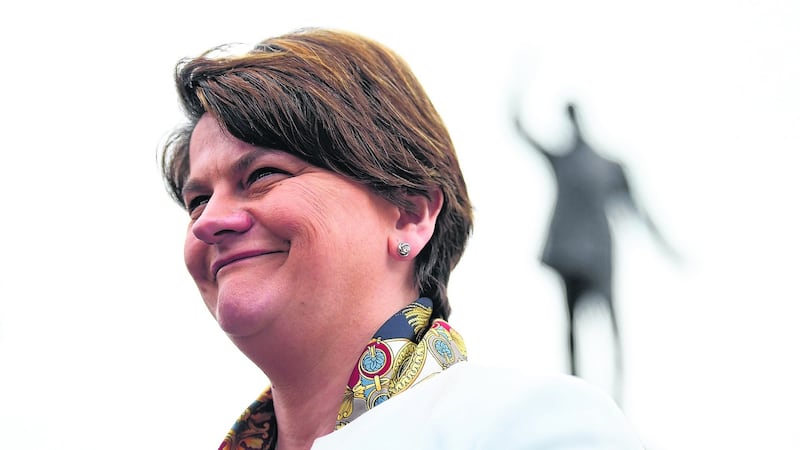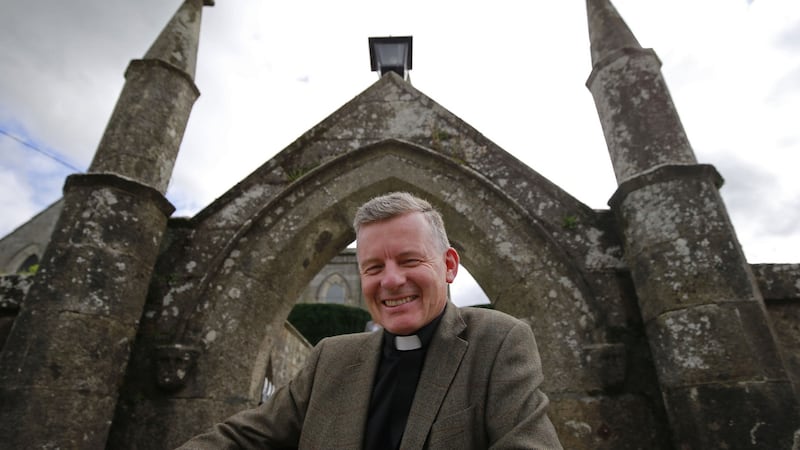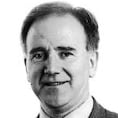Standing before the impressive Neo-Romanesque doorway of St Ann's Church of Ireland on Dublin's Dawson Street, Fred Deane is handing out leaflets for a prayer service to those interested, as Luas trams pass by.
“We’re the church for the heart of the city, with the city at its heart,” says Deane.
Most days, St Ann's offers the Eucharist at lunchtime, from a rota of Church of Ireland priests. But this is Monday and Mr Deane, caretaker there for almost 10 years, conducts the service himself.
“All are invited, the policy is simple, he says. “There might be only myself, the celebrant. There might be three, there might be four. On a Tuesday we have a laying on of hands for the sick, which is a little bit different. It tends to get a few extra people.”
One of oldest continuous Church of Ireland parishes in central Dublin, St Ann’s has survived the ebb and flow of population movement for more than 300 years, with the tide seeming to be in its favour again.
“For many, many years here there were no young children, small children, with their parents. Now on a Sunday here we could have 15, 20 children, which is fantastic,” he says. “Then the older parishioners, who grew up here as children, they moved out of the city but still come back on a Sunday. For many years it was just them.”
At this time of year “the Sunday congregation is up. Yesterday it was 97 roughly, to a 100. That’s not every week because obviously at this time of the year with visitors, it swells the numbers a little bit. The average congregation would probably be 60 to 70,” he says.

Divergent political views
The church is steeped in history. Dracula author Bram Stoker married Florence Balcombe there in 1878, Irish republican Wolfe Tone married Martha Witherington in 1785, Ireland's first president Douglas Hyde and fifth president Erskine Childers regularly worshipped there.
Nationally, however, the picture is not so encouraging. Participation in Church of Ireland services continues to drop, according to a survey conducted by the church itself. Just 64,700 people attended Church of Ireland Easter services in 2016, compared to 76,000 in 2013.
This month, however, marks a significant anniversary in its history. It is 150 years ago this month that royal assent was given in London to the Irish Church Act, paving the way for disestablishment in 1871, when the Church of Ireland was removed as Ireland’s state church.
One of the more remarkable institutions on this island is the Church of Ireland. No other in our past has so successfully accommodated as many people of divergent political views. It continues to do so today.
So what is it that allows this church, with such disparate political allegiances among its membership, to stay together?
'I wouldn't put too high a wall or too unyielding a wall around the church.' Erecting walls has not been the Anglican way
Perhaps it is as Bishop of Clogher John McDowell told an Irish Association conference in Dublin earlier this month, somewhat tongue-in-cheek, "that in the Anglican tradition one is free to believe almost anything, provided that is, you don't hold the belief too fervently".
More seriously, a 2003 scoping study on sectarianism conducted within the church following the Drumcree crisis, titled The Hard Gospel, addressed the matter with some humility.
It described the Church of Ireland as “one of many valid expressions of Christian faith, and that even those who thought that the Church (of Ireland) ‘taught truer doctrines’ did not believe this meant the Church (of Ireland) had a monopoly on Christian teaching”.
One of the major players in preparing that document was current Church of Ireland Archbishop of Dublin Michael Jackson. The church's Primate of All Ireland, Archbishop Richard Clarke, put it like this at a 2003 Irish Association Conference in Armagh.
He said he held firmly to the view "that there is one Holy Catholic and Apostolic Church and that within that church there are rather a large number of traditions – a Roman Catholic tradition, an Orthodox tradition, an Anglican tradition, a Presbyterian tradition, a Baptist tradition and so on. I wouldn't put too high a wall or too unyielding a wall around the church."
Erecting walls has not been the Anglican way.
Today the Church of Ireland has about 375,400 members on the island; 249,000 in Northern Ireland and 126,400 in the Republic. The latter figure, from the 2016 census, indicated a drop of 2 per cent on the 2011 total.
All of the four main Christian denominations on the island – Catholic, Church of Ireland, Presbyterian, and Methodist – experienced a drop on their 2011 figures in the 2016 census.
Though the largest Protestant Church on the island as a whole, it remains a minority in both. In Northern Ireland, the Catholic and Presbyterian churches are larger (in that order) while in the Republic it is second to the Catholic Church.

Questioned about the role the Church of Ireland plays in her life, DUP leader and former Northern Ireland first minister Arlene Foster says: "I have throughout my life been a Church of Ireland parishioner. First attending St Mark's Parish at Aghadrumsee, then moving to Holy Trinity Church of Ireland in Lisnaskea after my father was shot and we were forced from our rural Fermanagh home to now, where I attend Colebrooke Church of Ireland since my marriage, some 24 years ago. Like many others, the Church and my faith have been very important in my life."
She says disestablishment of the Church of Ireland 150 years ago was “a truly remarkable and fascinating period of time”, though “essentially the Irish Church Act and eventual disestablishment was a political decision to appease those who wanted Home Rule. Fast forward 150 years and you wonder what many would think of today’s social and political landscape. Disestablishment did not solve all the problems that existed, as some thought would happen,” she adds.
“The Church of Ireland has been able to chart the course of the changing political landscape from the creation of Northern Ireland to the present day.
“In Fermanagh, the Church of Ireland has a strong presence [more so than the other five Northern counties] and throughout a turbulent period in Northern Ireland’s history has continued to grow.”

Minister for Transport Shane Ross says: "As a child I was a parishioner at Kilternan Church of Ireland and later went to Taney when at school in Dundrum. At the time Church of Ireland people were a little more detached from the wider community than they are now.
“Today the Church of Ireland is a totally committed member of the cosmopolitan community that is Irish society. The Church of Ireland manages to retain its ethos, while embracing all the activities and values of citizenship.”
Labour TD for Limerick Jan O'Sullivan says disestablishment had been, in her view, "a positive" for the Church of Ireland.
“I don’t think any church should be so closely entwined with the State that it would be described as ‘established’,” she adds.
“Churches are about a belief system that should stand on its own merits, not propped up in any way by the State. I would say the same about the unhealthy relationship between the Catholic Church and the Irish State in the early decades of independence.
“I support a pluralist state that nourishes people of all religions and none and frees people to make their own conscientious decisions and choices.
“As a child growing up Protestant in 1950s and ’60s Ireland, I was very conscious of being different. I lived in a small village in Clare and went to school in the city [Limerick] while all my neighbours went to the local primary school a minute’s walk from our house. The Catholic Church was beside the school and while I walked to church on Sundays with my parents and brother up the road, we met everyone else in the parish walking down to road to their church. I couldn’t but be aware that my family was the odd one out!
“I believe being part of a minority group can make you resilient, self-reliant, questioning and understanding of others who are different in other ways,” she says.

Former minister of State for Food and Green Party leader Rev Trevor Sargent says the Church of Ireland's governing structure, the General Synod, "which may have been cutting edge in the 19th century" now "needs to be slimmed down".
“More broadly, if the Church of Ireland is to be relevant to 21st-century Ireland it must do so through contributions in the social, environmental, and economic areas. That will be the measure,” says Sargent, who “grew up in Dublin as a cradle Anglican. All our neighbours, as far as I can tell, were Roman Catholic. For six days of the week we all played on the street together. However, Sundays were different. No playing on the street. Morning worship, Sunday school, family dinner and watching a black and white film on television in the afternoon, or a Sunday drive to visit relatives, were typical, and indeed very enjoyable, memories of Sabbath observance growing up.”
He adds: “As a member of a minority tradition growing up, I was always aware of diverse religious views around me. A number of friends were Jewish, Roman Catholic, and more latterly, Muslim. Looking back, others were probably avowed agnostics or atheists, wiccan, humanists, and various other minority traditions but labels were rarely ascribed – they were just interesting friends.”
Interestingly, he says, more than a few in the Church of Ireland are strongly Green into their politics.
“The Green Party is religiously quite a broad church, so to speak. It has a fair share of atheists, in my experience, but equally many ecologically-minded members of diverse faith communities, from Jesuits to Quakers.”
Canon Patrick Comerford, Priest in Charge of the Rathkeale Group of parishes in Limerick diocese, says leading Church of Ireland figures such as Archbishop Richard Trench of Dublin feared the "very worst for the future" and a "very dismal catastrophe". However, Trench's worst fears were never realised, says Comerford.'
'The identification of the Church of Ireland with the Church of England reflects not just historical ignorance but often deep-rooted bigotry'
“The Church of Ireland was left in possession of the cathedrals, churches and church schools then in use – which might not have been the fate of an established Church of Ireland at independence half a century later.”
Theologians from the Church of Ireland have had an influence on the Anglican Communion internationally that far outweighs the size of the church. It also pioneered an adventurous approach to the ordination of women while the Church of England was still tied up in irrelevant debates.
“Many problems remain in the Church of Ireland, but it is possible to face and debate them because of disestablishment, which has been good not only for the Church of Ireland but for the wider Anglican Communion,” he says.
Dean of Waterford, the Very Rev Maria Jansson, says the 150th anniversary offers the Church of Ireland an opportunity to stop and think about the future.
“From being a post-colonial institution, the Church of Ireland has become, in urban areas especially, the spiritual home for people of many different spiritual traditions and nationalities,” she says.
“The perception of the church as a relic of old decency is very far from the reality and the identification of the Church of Ireland with the Church of England reflects not just historical ignorance but often deep-rooted bigotry,” she adds. “Tribal affiliation no longer means anything to young people looking at a world in catastrophic freefall as a result of cancerous capitalism and ecological destruction.”
There are internal challenges to be met: changing demographics, the rise of the far right in evangelical circles, structural homophobia and group think clericalism that is profoundly misogynistic. However, the greatest challenge is to take the gospel message of co-responsibility and connecting with the real issues that will decide whether we will have a future at all as a planet, not to mind a church.
Dr Ida Milne, lecturer in European history at Carlow College, says disestablishment meant little to most of our ancestors who made their livings as tenants rather than the professional classes that were a key element of the political and social Protestant establishment.
“We probably find the historic connection to the Church of Ireland establishment and the inequality it created in society an embarrassment, and would in the past have been teased about it,” she says.
"Our family was broadly pleased to be part of the new independent Ireland, when it came, and showed that in many quiet ways. As a Protestant child in Wexford, the only difference was the church on Sundays. We were firmly part of the community as children, loved and minded like others. My sister and I did Irish dancing, badly in my case, with costumes loaned for feiseanna by our neighbours, who happened to be Catholic.
“We had a hurling pitch on the farm. Our mother and aunts were in the ICA [Irish Countrywomen’s Association], our father in Macra na Tuaithe. In his later years, he became a keen local historian who was on the 1798 bicentenary committee. Of that, tellingly, he said: ‘If we had put as much work into the rebellion itself, we might have won’.”












